Fo Guang Shan Hwei Chan Temple Introduction
The traditional temples are often hidden in the mountains, seeking tranquility and peace, while Huizhong Temple showcases a modern aspect of "great concealment in the city." It stands solemnly in the seventh phase redevelopment zone of Taichung City, becoming a spiritual oasis in the urban landscape. When Master Hsing Yun first came to Taiwan, he resided at Leiyin Temple in Yilan. In 1965, he established Shoushan Buddhist Academy in Kaohsiung, and in 1967, he acquired land in Dashi Township, Kaohsiung, laying the foundation for the establishment of Fo Guang Shan. In 1992, the Eastern Taiwan branch was established to serve the believers in Taichung City, and in 1996, the "Guangming Academy" was established to enhance cultural and educational development. After more than a decade of unified efforts by the Fo Guang community, the number of believers in Taichung surged, leading to insufficient space. After much searching, in August 2004, following an inspection by the Master and elder monks, the Fo Guang Shan Administrative Council decided to convert the Formosa Restaurant located on Huizhong Road into a comprehensive, diverse, and modern Buddhist cultural and educational center for the believers in Taichung, naming it Huizhong Temple. Huizhong Temple is five stories high, with a total floor area of over 3,000 ping, containing numerous large and small compartments. Huizhong Temple upholds the spirit of respecting existing buildings and, under the wise guidance of the Master, chose to retain the original architectural layout. Therefore, Huizhong Temple is different from the solemnity of traditional temples with their intricate carvings and paintings, maintaining the restaurant's original appearance and layout, with an exterior in European Baroque style. Abbot Jueju said, "It's quite a coincidence that the restaurant was adorned with elephants as decorations; in Buddhism, elephants symbolize great conduct, perhaps this place has always been destined to be connected with Buddhism." Originally, the temple and restaurant had no relation, but surprisingly, the restaurant space was only slightly modified to become a serene and elegant place for practice. A professor from Nanhua University’s architecture department who visited the temple once remarked, "This is truly an astonishing and successful transformation in architecture." In 2007, monks from Chulalongkorn University in Thailand visited the temple; as they stepped off the tour bus, they were immediately greeted by Huizhong Temple, and everyone’s eyes widened in admiration. After the visit, the first question during the discussion was, "Do all the temples of Fo Guang Shan look like this?" Transforming a restaurant into a place of practice, blooming a pure white elegant lotus flower in the midst of the bustling world, how could it be done without "magic"? This is said to mean "where there is Dharma, there is a way." Thus, the compartments became classrooms and dormitories, and the large banquet hall on the third floor became the Great Buddha Hall. The circular roof created an excellent echo effect; during Dharma services, the chanting resonated beautifully through the circular roof, creating a harmonious and continuous sound. Standing in front of Huizhong Temple, you will see that the central glass doors are always open, inviting those with affinity to connect. As you enter, you are greeted by two spiraling staircases, which are popular spots for couples to take wedding photos. The ceiling features a soaring glass skylight, and whenever sunlight falls, the shimmering golden light resembles a world of seven treasures and glazed ceramics. The grand atrium embodies an atmosphere of elegance and solemnity. The service counter in the circular space at the west entrance is dedicated to serving visiting believers. It’s highly recommended to take a stroll in Huizhong Temple now; its diverse and rich facets are sure to provide you with a unique new experience!









































